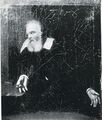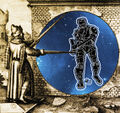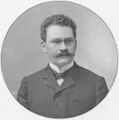Template:Selected anniversaries/June 22: Difference between revisions
No edit summary |
No edit summary |
||
| (10 intermediate revisions by the same user not shown) | |||
| Line 6: | Line 6: | ||
File:Anarchimedes measuring Galileo.jpg|link=Anarchimedes|1633: Rogue mathematician and alleged supervillain taunts [[Galileo Galilei (nonfiction)|Galileo Galilei]] for recanting, daring Galileo to "tell it like it is, and let them burn you for it." | File:Anarchimedes measuring Galileo.jpg|link=Anarchimedes|1633: Rogue mathematician and alleged supervillain taunts [[Galileo Galilei (nonfiction)|Galileo Galilei]] for recanting, daring Galileo to "tell it like it is, and let them burn you for it." | ||
||1792: James Beaumont Neilson born ... engineer and businessman. | ||1792: James Beaumont Neilson born ... engineer and businessman ... iron smelting. Pic. | ||
||1837: Paul Morphy born ... chess player. | |||
||1837: Paul | ||1837: Paul Gustav Heinrich Bachmann born ... mathematician. His major works include ''Analytische Zahlentheorie'', a work on analytic number theory in which Big O notation was first introduced. Pic. | ||
|| | ||1848: William Macewen dies ... surgeon and neuroscientist. Pic. | ||
||1860: Mario Pieri born ... mathematician who is known for his work on foundations of geometry. | ||1860: Mario Pieri born ... mathematician who is known for his work on foundations of geometry. Pic. | ||
File:Hermann Minkowski.jpg|link=Hermann Minkowski (nonfiction)|1864: Mathematician and academic [[Hermann Minkowski (nonfiction)|Hermann Minkowski]] born. He will show that Albert Einstein's special theory of relativity can be understood geometrically as a theory of four-dimensional space–time, since known as the "Minkowski spacetime". | File:Hermann Minkowski.jpg|link=Hermann Minkowski (nonfiction)|1864: Mathematician and academic [[Hermann Minkowski (nonfiction)|Hermann Minkowski]] born. He will show that Albert Einstein's special theory of relativity can be understood geometrically as a theory of four-dimensional space–time, since known as the "Minkowski spacetime". | ||
||1874: Howard Staunton dies ... chess player. | ||1874: Howard Staunton dies ... chess player. | ||
| Line 26: | Line 24: | ||
||1885: Milan Vidmar born ... engineer and chess player. | ||1885: Milan Vidmar born ... engineer and chess player. | ||
||1892: Pierre Ossian Bonnet dies ... mathematician and academic. | ||1892: Pierre Ossian Bonnet dies ... mathematician and academic. Pic. | ||
||1894: Bernard Ashmole born ... archaeologist and historian. Pic search: https://www.google.com/search?q=bernard+ashmole | |||
||1899: Richard Gurley Drew born ... engineer, invented Masking tape. | ||1899: Richard Gurley Drew born ... engineer, invented Masking tape. | ||
||1906: William Kneale born ... logician and philosopher. | ||1906: William Kneale born ... logician and philosopher ... best known for his 1962 book ''The Development of Logic'', a history of logic from its beginnings in Ancient Greece written with his wife Martha.Pic search yes: https://www.google.com/search?q=william+kneale | ||
||1906: Eduard Ott-Heinrich Keller born ... mathematician who worked in the fields of geometry, topology and algebraic geometry. He formulated the celebrated problem which is now called the Jacobian conjecture in 1939. Pic. | ||1906: Eduard Ott-Heinrich Keller born ... mathematician who worked in the fields of geometry, topology and algebraic geometry. He formulated the celebrated problem which is now called the Jacobian conjecture in 1939. Pic. | ||
| Line 40: | Line 40: | ||
||1921: Nicolaas 'Nico' Godfried van Kampen born ... theoretical physicist, who worked mainly on statistical mechanics and non-equilibrium thermodynamics. No pic. | ||1921: Nicolaas 'Nico' Godfried van Kampen born ... theoretical physicist, who worked mainly on statistical mechanics and non-equilibrium thermodynamics. No pic. | ||
|| | ||1924: Larkin Kerwin born ... physicist and academic. Pic. | ||
||1925: Felix Klein dies ... mathematician and academic ... mathematics educator, known for his work in group theory, complex analysis, non-Euclidean geometry, and on the connections between geometry and group theory. His 1872 Erlangen Program, classifying geometries by their underlying symmetry groups, was a highly influential synthesis of much of the mathematics of the day. Pic. | |||
||1925: Felix Klein dies ... mathematician and academic ... mathematics educator, known for his work in group theory, complex analysis, non-Euclidean geometry, and on the connections between geometry and group theory. His 1872 Erlangen Program, classifying geometries by their underlying symmetry groups, was a highly influential synthesis of much of the mathematics of the day. | |||
||1930: Reinhold Remmert born ... mathematician. He established and developed the theory of complex-analytic spaces in joint work with Hans Grauert. Pic. | ||1930: Reinhold Remmert born ... mathematician. He established and developed the theory of complex-analytic spaces in joint work with Hans Grauert. Pic. | ||
||1940: Daniel Quillen born ... mathematician. He is known for being the "prime architect" of higher algebraic K-theory, for which he was awarded the Cole Prize in 1975 and the Fields Medal in 1978. Pic: https://ronsview.org/2011/05/10/daniel-quillen/ | ||1940: Daniel Quillen born ... mathematician. He is known for being the "prime architect" of higher algebraic K-theory, for which he was awarded the Cole Prize in 1975 and the Fields Medal in 1978. Pic: https://ronsview.org/2011/05/10/daniel-quillen/ | ||
||1953: Mauro Francaviglia born ... mathematician and academic. Pic search: https://www.google.com/search?q=mauro+francaviglia | |||
||1953: | ||1953: Hollow Nickle case: a newspaper boy (fourteen-year-old Jimmy Bozart), collecting for the Brooklyn Eagle, at an apartment building at 3403 Foster Avenue in the New York City borough of Brooklyn, was paid with a nickel (U.S. five-cent piece) that felt too light to him. When he dropped it on the ground, it popped open, revealing that it contained microfilm. The microfilm contained a series of numbers. He told the daughter of a New York City Police Department officer, and that officer told a detective who in two days told an FBI agent about the strange nickel. Pic. | ||
||1954: Karl Taylor Compton dies ... physicist and president of the Massachusetts Institute of Technology (MIT) from 1930 to 1948. Pic. | ||1954: Karl Taylor Compton dies ... physicist and president of the Massachusetts Institute of Technology (MIT) from 1930 to 1948. Pic. | ||
| Line 64: | Line 60: | ||
File:Gabriel Sudan 1932.jpg|link=Gabriel Sudan (nonfiction)|1977: Mathematician [[Gabriel Sudan (nonfiction)|Gabriel Sudan]] dies. He discovered the Sudan function, an important example in the theory of computation, similar to the Ackermann function. | File:Gabriel Sudan 1932.jpg|link=Gabriel Sudan (nonfiction)|1977: Mathematician [[Gabriel Sudan (nonfiction)|Gabriel Sudan]] dies. He discovered the Sudan function, an important example in the theory of computation, similar to the Ackermann function. | ||
||1977: | ||1977: Marston Morse dies ... mathematician best known for his work on the calculus of variations in the large, a subject where he introduced the technique of differential topology now known as Morse theory. Pic. | ||
||1978: Charon, Pluto's first satellite, was discovered at the United States Naval Observatory by James W. Christy. | ||1978: Charon, Pluto's first satellite, was discovered at the United States Naval Observatory by James W. Christy. | ||
| Line 72: | Line 68: | ||
||2004: Bob Bemer dies ... computer scientist and engineer. | ||2004: Bob Bemer dies ... computer scientist and engineer. | ||
||2004: Thomas Gold dies ... astrophysicist. | ||2004: Thomas Gold dies ... astrophysicist. Pic. | ||
||2004: Victor Lvovich Talrose dies ... Russian scientist and mass spectrometrist ... the "Father of Russian Mass Spectrometry". Pic. | |||
</gallery> | </gallery> | ||
Latest revision as of 18:25, 6 February 2022
1633: The Holy Office in Rome forces Galileo Galilei to recant his view that the Sun, not the Earth, is the center of the Universe in the form he presented it in, after heated controversy.
1633: Rogue mathematician and alleged supervillain taunts Galileo Galilei for recanting, daring Galileo to "tell it like it is, and let them burn you for it."
1864: Mathematician and academic Hermann Minkowski born. He will show that Albert Einstein's special theory of relativity can be understood geometrically as a theory of four-dimensional space–time, since known as the "Minkowski spacetime".
1910: Engineer, inventor, and pioneering computer scientist Konrad Zuse born. He will invent the Z3, the world's first working programmable, fully automatic computer.
1977: Mathematician Gabriel Sudan dies. He discovered the Sudan function, an important example in the theory of computation, similar to the Ackermann function.




